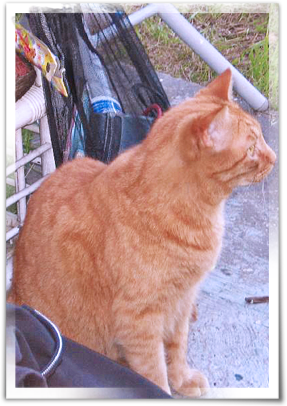Hurricane Katrina

Jul 22 2006 ~ In Shannon's Memory
- Birthday Of An Angel, Gone
- Small Bites: Animal News
- Hundreds Roam, Need Foster
- Trial: Kern County, CA Cruelty
- Animal Disaster Training For LA
- Found: Orange/Wh Cat, Lakeview
- Found: Chance, Shiba Inu Mix
- Katrina Survivor Jackson Killed?
- Volunteer Recruit: Big Rig Fix
- Big Fix Impact In Katrina Torn LA
- Animal Evacuation Volunteers
- Campbell, A Parrot, Goes Home
- Katrina Animal Culture Wars
- Snob, Racist, Animal Defender?
Shannon Hartwick Moore
July 22, 1969 ~ May 30, 2006
Happy Birthday Shannon, Angel
Light a candle in memory of Shannon.
~ Memorial Guest Book
~ Shannon, I Forgot To Tell You
~ Memories Of Shannon Blog
~ Photos Of Shannon
~ Photos: People & Pets Rally
Small Bites
News named Small Bites as a reminder to donate small-bite food (or cat food) for Gulf animals.Who Can Help 3 Rescued Pups?
Reply To: Robin Beaulieu, 504-913-2328 ~ 7/20/06: ARNO received three puppies yesterday. They are about 5 months old (so cute!) and have ringworm. Robin cannot shelter them at ARNO with ringworm. She has no fosters available at the moment. Please contact Robin at ARNO if you can help.
Plaquemines Feral Cat TNR Program
Reply To: Ramona Billot ~ Plaquemines residents, are you feeding or caring for feral cats? Are you willing to join the solution to overpopulation? We are looking for people who care and can help implement a TNR (trap, neuter, return) program in Plaquemines Parish. Resources are provided. Please be part of the solution, not the problem.
Need Cat Food Transport To ARNO
Reply To: Kelle kelle@ev1.net, 832-969-8831 ~ I am a former ARNO volunteer who now rescues in Houston and gets free donations of cat/dog food from two local stores. I have 20+ bags of cat food I want ARNO to get in New Orleans. If you or someone you know is headed that way, please consider delivering this cat food. Your kindness will help sustain life for cats, and now many kittens, stranded on deserted streets since Katrina. If you have more food to donate along with mine, please do so!
RV Needed For Animal Rescue
Reply To: Susan Meyer, Kat5 Rescue ~ A donated RV with a working bathroom (or pull trailer with bathroom) would help animal rescue efforts immensely. We came together for animals in the wake of Hurricane Katrina. Since then we've been alerted to animals in need nationwide. An RV with facilities for volunteers to clean up and sleep would better equip teams to rescue animals.
A Family For Fat Cat?
Reply To: Kristen Krismastym@yahoo.com ~ 7/21/06: A fat black and white cat, about 7 years old, needs a responsible and loving home. "Fat Cat" is fixed and litterbox trained. Very affectionate and funny. He was abandoned in a post-Katrina home like so many others. Email Kristen for photo and information.
Do Your Senators Back The PETS Act?
Kinship Circle ~ The federal Pets Evacuation & Transportation Standards (PETS) Act passed the U.S. House and is before the Senate. Ask your U.S. Senators to support the PETS Act.
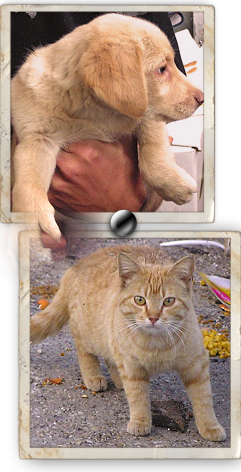
Can You Help A Post-Katrina Stray?
Reply To: Kathy Sweeney
7/20/06 ~ Deeply committed New Orleans residents who've watched over strays since big groups left…need our help. Trappers and foster/adopters are critically needed. Over-full local shelters can't accept street animals. Food stores are unpredictable and fosters are nonexistent. One feeder has 28 cats in her home as she feeds more on the streets and holds down two jobs! We need trappers and no-kills anywhere to save animals at risk from demolition bulldozers and aggressive, starving dog packs.
To help left-behind animals, you can: Foster, assist with trapping and feeding, donate (lots of) food, cages, etc.
Hundreds Still Roam NOLA Streets
Reply To: LeAnne Goudeau
LA Pet Rescue, 337-513-2344
Roaming NOLA Pet Photos
Do you work with a shelter able to take some of NOLA's roaming animals? Can you foster/adopt? Food/water volunteers now fill their homes with Katrina animals. They fear dog packs, stranded animals themselves, who've killed roaming cats over the past few weeks. Please Contact local 501c3 no-kill shelters to see if they have space available.
Reply To: Kathy Sweeney
7/20/06 ~ Deeply committed New Orleans residents who've watched over strays since big groups left…need our help. Trappers and foster/adopters are critically needed. Over-full local shelters can't accept street animals. Food stores are unpredictable and fosters are nonexistent. One feeder has 28 cats in her home as she feeds more on the streets and holds down two jobs! We need trappers and no-kills anywhere to save animals at risk from demolition bulldozers and aggressive, starving dog packs.
To help left-behind animals, you can: Foster, assist with trapping and feeding, donate (lots of) food, cages, etc.
Hundreds Still Roam NOLA Streets
Reply To: LeAnne Goudeau
LA Pet Rescue, 337-513-2344
Roaming NOLA Pet Photos
Do you work with a shelter able to take some of NOLA's roaming animals? Can you foster/adopt? Food/water volunteers now fill their homes with Katrina animals. They fear dog packs, stranded animals themselves, who've killed roaming cats over the past few weeks. Please Contact local 501c3 no-kill shelters to see if they have space available.
Landmark Trial: Kern County, CA
Due to length, below are article excerpts only. Click here to see Pattie Lock vs. County Kern case file.Kern County California Charged With Failure to Comply With Vincent And Hayden Laws, By Laura Allen ~ 7/19/06: This landmark case seeks a permanent injunction requiring Kern County Animal Control to comply with California's The Hayden Law requires public shelters, animal control, humane societies and nonprofit rescues in counties with 100,000+ populations to spay/neuter animals before selling or giving them away. If a veterinarian certifies that health issues prevent spay/neuter at that time, the shelter, agency or rescue group must obtain a deposit from an adoptee or purchaser. The deposit is refunded if the animal is sterilized within 30 days. A copy of this law is in Animal Law Coalition's Resources section.
The Hayden Law compiles various amendments designed to reduce shelter euthanasia statewide, encourage [guardian] redemption and adoptions, and improve animal treatment by 2010… The Hayden Law also mandates that instead of killing stray animals, public agencies must release them to any 501c3 nonprofit that requests them… Other provisions require humane treatment of animals held by shelters, including veterinary care. In 2004 Patricia Lock filed her case against Kern County Animal Control for violations of the Hayden Law. Lock claims animals are not held for the requisite 4 business days and are quickly euthanized on a routine basis. Cats thought to be feral are not held for the statutory period or behavior-tested. They are killed right away. Animals deemed sick are euthanized rather than treated or even examined by a veterinarian.
Lock's complaint further alleges:
- Cats are killed with painful Euthanol-6.
- No shelter personnel are trained to use Euthanol-6.
- Nonprofits are denied chance to save animals.
- People are denied search for lost pets.
- Animals are not spay/neutered before release.
- Animals are released without "proof of ownership."
- Strays are dumped after hours in bins. Cats mixed with dogs in bins are sometimes killed.
- The County alledgedly sold needed shelter space to Bakersfield and always limits animal intake.
According to Patricia Lock's attorney Kate Neiswender, "This is a case of ongoing abuse and failure to follow laws in Kern County. They kill 50 to 75 animals each day. These figures are the direct result of shelters refusing to work with rescue groups, keeping stray animals behind locked doors, and failure to spay/neuter."
Shine Light On Kern County Kill Rate
Spay/Neuter Event
When: 7/30/06, begins 6:30 a.m.
Where: 200 China Grade Loop / Bakersfield, CA 93308
What: Amanda Foundation Mobile Spay/Neuter Clinic
Reply To: Lisa Tipton, 661-803-8462
Dog handling volunteers are needed for a spay/neuter event in Bakersfield, CA on 7/30. We also need crates, sheets, blankets, towels. The event opens with a Pet Fair to educate Kern County residents about subsidized services. If you are disgusted with the shelter's kill rate and substandard conditions, this is your chance to do something. We'll have a live radio remote and national press releases circulated pre-event. Pet Fair volunteers are needed too. In Kern County, which has no low-cost/accessible spay/neuter program, the cat kill rate is as high at 98% and 90% for dogs at Bakersfield shelter. In 2004, Bakersfield shelter was named one of the nine neediest shelters nationwide by Animal People Magazine.
Peaceful Demonstration Outside Courthouse
When: 7/31/06, begins 9:00 a.m.
Where: 1415 Truxton Avenue / Bakersfield, CA 93301
What: Protest landmark shelter abuse case.
Reply To: Lisa Tipton, 661-803-8462
Lock vs. KCAC goes to trial at 9am on 7/31 in a landmark case that has managed to evade publicity. If the case loses, no Kern County shelters will be held accountable for violating cruelty laws. A 2004 lawsuit filed against Kern County Animal Control lists numerous violations of California's Hayden Law SB 1785.
Spay/Neuter Event
When: 7/30/06, begins 6:30 a.m.
Where: 200 China Grade Loop / Bakersfield, CA 93308
What: Amanda Foundation Mobile Spay/Neuter Clinic
Reply To: Lisa Tipton, 661-803-8462
Dog handling volunteers are needed for a spay/neuter event in Bakersfield, CA on 7/30. We also need crates, sheets, blankets, towels. The event opens with a Pet Fair to educate Kern County residents about subsidized services. If you are disgusted with the shelter's kill rate and substandard conditions, this is your chance to do something. We'll have a live radio remote and national press releases circulated pre-event. Pet Fair volunteers are needed too. In Kern County, which has no low-cost/accessible spay/neuter program, the cat kill rate is as high at 98% and 90% for dogs at Bakersfield shelter. In 2004, Bakersfield shelter was named one of the nine neediest shelters nationwide by Animal People Magazine.
Peaceful Demonstration Outside Courthouse
When: 7/31/06, begins 9:00 a.m.
Where: 1415 Truxton Avenue / Bakersfield, CA 93301
What: Protest landmark shelter abuse case.
Reply To: Lisa Tipton, 661-803-8462
Lock vs. KCAC goes to trial at 9am on 7/31 in a landmark case that has managed to evade publicity. If the case loses, no Kern County shelters will be held accountable for violating cruelty laws. A 2004 lawsuit filed against Kern County Animal Control lists numerous violations of California's Hayden Law SB 1785.
Animal Disaster Aid Required In Louisiana
7/18/06 Pam Leavy ~ I've compiled information about training required in future Louisiana disasters.- Join a humane organization. It is far more efficient for authorities to accept aid from an organization with pre-qualified, trained volunteers.
- Join LSART, Louisiana State Animal Response Team.
- Train as a disaster responder with one of these groups:
HSUS NDART
UAN (Red Rover)
Code 3 - Take online FEMA courses: training.fema.gov/EMIWeb/IS/
Though FEMA credentials may not be mandatory until 2007, get started now.
For evacuation shelters:
ICS 100: Intro to Incident Command
ICS 200: Basic Incident Command
For response shelters, all of the above plus:
NIMS 700: Nat'l Incident Management
NIMS 800: National Response Plan
For field rescue, all of the above, plus:
IS 10: Animals in Disaster Module A
IS 11: Animals in Disaster Module B
For water rescue, all of the above plus:
Additional technical water rescue. Refer to Code 3 requirements. - Vaccinations Required/Recommended
Tetanus / Hepatitis A & B / Rabies pre-exposure
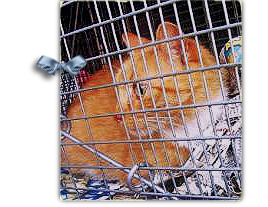
Found: Orange Cat
- Breed: Orange White Tabby-Tiger Shorthair Domestic Cat
- Gender: Female
- Age: 2 Years
- Size: Small
- Found ID: PF63243
Description: This beautiful girl is an orange and white domestic shorthair. She is pretty scared but does not appear feral. She was not ear-tipped when trapped but she has a small one now. Since being trapped, the Contact has spent time with her and says she is very friendly and without issues.
Last Seen: She was trapped in the 200 block of 28th Street in Lakeview, LA, a suburb of New Orleans (Orleans Parish). Location is between Pontchartrain and Fleur de Lis.
Contact: 920-499-7475
Petfinder Emergency Rescue
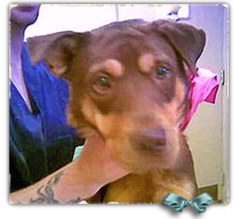
Katrina Survivor Jackson May Be Killed
- Breed: Brown/Tan Labrador Retriever-Doberman Pinscher Mix
- Color/Markings: Brown body/face, gold facial marks, curled tail.
- Gender: Male / Age: About 4 Years
- Weight: About 40 Pounds
- Found ID: PF63146
- Winn Dixie: HK1021-15
Found/Last Seen: On 10/21/5, Ben Bass found Jackson (rescue name) on Camelot St, New Orleans LA 70112. He was taken to Winn Dixie. Then Jackson went to Animal Friends in Pittsburgh, PA where he faces euthanasia.
Notes: In Oct 2005, my husband and I went to New Orleans to recover animals from empty homes, on streets, in rafters… We worked closely with Best Friends, Louisiana Humane Society, and the Winn Dixie unit. When time to leave, we were encouraged to bring animals to Pittsburgh to search for guardians via Internet or find new homes. Most have been adopted, with a boxer mix happily in our own home.
All have hope for a future, but Jackson. He is a sweet chocolate/tan Labrador-Doberman with possible Chow. I brought Jackson to a Pittsburgh no-kill (per their request). This shelter is set to euthanize him. Jackson loves people and is starved for direction from a doggie mom/dad. He survived the storm and floods, plus heartworm treatment and a rare venereal disease which both nearly killed him. After five months rehab at a doggie spa, Jackson returned to the "no kill" shelter. Jackson is altered, current on shots and healthy.
But this shelter "black-listed" Jackson, a dog cage-crazy after so long. He lunges if a child passes his cage. If the child is with an adult or Jackson is leashed, he doesn't lunge. For this, a survivor of untold trauma gets sentenced to death?
I've seen Jackson play and share space with other dogs. I believe the shelter caused his behavior issues. He's been caged 9 months. The shelter won't let me take Jackson on outings. Clearly Jackson defends his cage, the only world he's known for about a year. Similarly labeled dogs adopted from this shelter are fine. Sadly, both the humane agent and I are at max animal capacity and can't adopt Jackson. I am stalling Jackson's death with a search for his NOLA [guardians]. Jackson is not dangerous. I can't bear to see this animal killed because a power-tripper at the "no kill" gave him one temperament test and didn't like results.
Contact: Shirl Ransley
412-519-6541, Saransley@aol.com
Jackson is currently sheltered at:
Animal Friends in Pittsburgh, PA
Kathleen Beaver: 412-566-2103
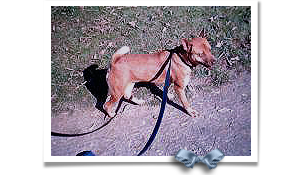
Found: Chance
- Breed: Red/White Shiba Inu Mix
- Gender: Female (intact)
- Age: 1 Year
- Size: Medium
- Found ID: PF63254
Description: This pretty Katrina dog looks to be mix of Shiba Inu and Chow or Basenji. She is a red color with some white and has a curly tail. She is heartworm negative.
Last Seen: New Orleans area? Original rescue site is unknown, but this girl wound up in Hattiesburg, MS and is now in Ohio.
Contact: 920-499-7475
Petfinder Emergency Rescue
Big Fix Rig In NOLA
Louisiana SPCA Hosts
Louisiana SPCA Hosts Big Fix Rig
When: Opens 7/24/06 for 2 weeks or longer
Where: Louisiana SPCA
701 Thayer Street
New Orleans, LA 70114
Contact: Kate Pullen, kate@la-spca.org
ARNO, Charlotte Bass Lilly ~ 7/20/06: Volunteers are needed for the Big Rig Fix. After success in Mississippi and St. Bernard Parish, the 53-foot mobile, high volume spay/neuter clinic (from Humane Alliance of Asheville, NC) rolls into Orleans Parish for a two or more week stay co-hosted by LA-SPCA and Spay-LA.
The Big Fix Rig offers $10 spay/neuter to rescues, colony managers, animal caregivers…and anyone who schedules to bring animals to Algiers, LA (on West Bank). LA-SPCA urgently needs a minimum 8 volunteers daily in critical roles. They also need Louisiana veterinarians willing to donate time for spay/neuter surgery.
Volunteers Needed
Intake: 3 volunteers from 6:45am to 9:00am to: Greet and thank participants, do paperwork and intake log, instruct animal guardians/caregivers, handle surgery co-payments, animal neckband/carrier IDs.
Recovery: 1 volunteer on Rig from 9:30am to 5:00pm to: Aid in surgery prep and vet staff needs, monitor anesthesia recovery, return animals to guardians/caregivers.
Data Entry: 1 person in Rig's surgical or recovery area to: Record accurate data on each surgery, manage written records, report daily surgery tallies to project lead.
Release: 3 volunteers from 3:00pm to 5:00 pm to: Greet guardians/caregivers and re-thank them, confirm each participant signs the log, give post-surgery home care instructions and help return animals.
Two Week Rig Schedule: Mon 7/24, Tue 7/25, Wed 7/26, Thu 7/27, Sun 7/30, Mon 7/31, Tue 8/1, Wed 8/2, Thu 8/3
To Volunteer, Contact:
Kate Pullen, kate@la-spca.org
Evacuation Volunteers Sought For Animals
~ Louisiana State Animal Response Team
~ petswelcome.com, pets-allowed-hotels.com
Shreveport Times, By John Hill ~ Seven weeks into hurricane season, animal groups seek volunteers to help with pet evacuations in the event of an emergency. A new state law officially includes companion animals in emergency response plans, but volunteers are still needed statewide to assist, said Rebecca Adcock of LSU School of Veterinary Science, of the State Animal Response Team.
Animal Mega Shelters have been selected: State Fair Grounds in Shreveport and the coliseum in Alexandria. Dr. Renee Porrier, a Lafayette vet, is coordinating volunteer efforts. Shelter volunteers can sign up at LSART's website.
The state emergency plan, mandated by Sen. Clo Fontenot's SB-607 bill and signed by Gov. Blanco last, launches pet evacuations 120 hours before hurricane landfall, said Ashley Rodrigue, communication director for the Louisiana Agriculture and Forestry Department.
Actual assisted pet evacuations will begin around 50 hours before a hurricane's expected landfall.
The main "message for the people of Louisiana is don't leave your pets at home," Adcock said. "Taking responsibility for your pet is critical."
Big Fix Makes Big Impact
Spay/Louisiana, 504-FIX-PETSPO Box 11149 / Jefferson, LA 70181
While Big Fix Rig was in Chalmette, a volunteer crew from Friends of the Animal Shelter of St. Bernard pitched in by 6:45am daily. Over five days, 163 cats and kittens were spay/neutered. Vouchers were distributed to [guardian] and feral caregivers unable to schedule an appointment. Photos: Spay/LA and SBP Animal Shelter spay/neuter animals on the Big Fix Rig.
Next Stop, LA-SPCA In Algiers, LA: To volunteer in Algiers, visit www.la-spca.org
Spay/Neuter Assistance Vouchers: Since St. Bernard Parish ACO Tina Bernard issued the first voucher on 6/22, over 100 more have gone out. We're hard at work to clear backlog requests and add veterinarians and voucher partners. Vouchers are for hurricane-impacted and low-income households in St. Bernard, Plaquemines, Orleans or Jefferson Parishes.
Statewide Spay/Neuter Referrals: Spay/LA's statewide referral program helps [guardians] find local humane groups or veterinarians for spay/neuter. [Guardians] may submit requests online and are emailed spay/neuter resources.
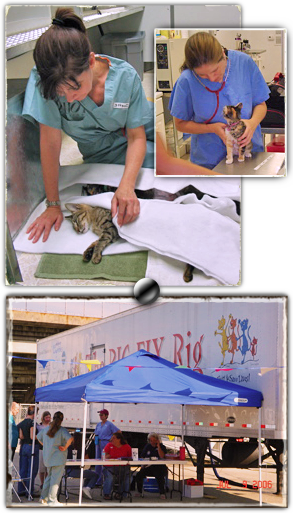

He's An On-Time God
Lead: He's an on time God, Yes He is Oh…
Choir: On time God… Yes He is
Lead: Job said
Choir: He may not come when you want Him
Lead: But He'll
Choir: Be there right on time
Lead: I'll tell ya He's an
Choir: On time God, yes He is
Lead: You can ask the children of Israel, trapped at the red sea, by that mean old Pharoah, and his army. They had water all around them, and Pharoah on their track. From out of nowhere, God stepped in and cut a highway, just like that, now let me tell you He's an…
Choir: On time God… Yes He is
Lead: You can ask the five thousand, hungry souls He fed, on the banks of the river, with two fish and five loaves of bread, what a miracle, He performed for the multitude, Oh what He did, way back then He'll do today for me and you.
Choir: On time God… Yes He is
Lead: He's on time
Choir: On Time
To Write Cheryl And Campbell:
Ms. Cheryl Sanchez
6040 Burgundy Street
New Orleans, LA 70117
Special thanks to Campbell's angels: Mom, Dr. Rich, LA-SPCA, HSUS, Country Boy Cages, Claire Rogers, Hansel Harlan, and all who continue to help animals like Campbell.
veni harlan
Lead: He's an on time God, Yes He is Oh…
Choir: On time God… Yes He is
Lead: Job said
Choir: He may not come when you want Him
Lead: But He'll
Choir: Be there right on time
Lead: I'll tell ya He's an
Choir: On time God, yes He is
Lead: You can ask the children of Israel, trapped at the red sea, by that mean old Pharoah, and his army. They had water all around them, and Pharoah on their track. From out of nowhere, God stepped in and cut a highway, just like that, now let me tell you He's an…
Choir: On time God… Yes He is
Lead: You can ask the five thousand, hungry souls He fed, on the banks of the river, with two fish and five loaves of bread, what a miracle, He performed for the multitude, Oh what He did, way back then He'll do today for me and you.
Choir: On time God… Yes He is
Lead: He's on time
Choir: On Time
To Write Cheryl And Campbell:
Ms. Cheryl Sanchez
6040 Burgundy Street
New Orleans, LA 70117
Special thanks to Campbell's angels: Mom, Dr. Rich, LA-SPCA, HSUS, Country Boy Cages, Claire Rogers, Hansel Harlan, and all who continue to help animals like Campbell.
veni harlan
Cheryl And Campbell's Reunion Story
Forwarded by Mariko Nakanishi with permission to reprint ~ Veni Harlan, July 2006: We fostered this lovely boy, along with about 65 other birds, when Rita approached and the Gonzales shelter had to evacuate, again. Unlike some, this guy still had papers (so many were lost or "eaten"). He'd been picked up 9/12/05 (two weeks post-Katrina) from Louis Armstrong Elementary School, tagged LA-SPCA #320. I learned this school was on St. Claude Avenue in the 9th Ward. Was he a school pet? Was this a drop off point? Or did someone attempt to steal the bird and then tire of the heavy burden, leaving him on the curb? We'll never know.Dr. Rich, whose Metairie avian practice was destroyed, deciphered his band, GSBC LA 96 1467, to mean the parrot was 9-years old and bred by a Gulf South Bird Club member. The parrot was underweight and wormy but okay. Like most Yellow Heads, this fellow dubbed "Satchmo" after Louis Armstrong, was vocally gifted. He sang, called out names, greeted visitors, and entertained everyone. Many toys inside his now deteriorating cage told us he was well loved.
Late last year, Cheryl Sanchez called looking for her parrot. She even sounded like Satchmo. When I confirmed her parrot was safe and sound, I heard muffled sobs. "My baby's name is Campbell." She explained how a young relative used Houston shelter computers to find Campbell on Petfinder. With no transportation or clear plan, I suggested she leave Campbell with us till settled. Over the next few months Cheryl called from Houston to check on her bird. When her daughter and son-in-law returned to New Orleans, Cheryl phoned to say they'd get Campbell. That day passed with no one for Campbell. We later learned that Cheryl's daughter woke to find her husband dead in the bed. The daughter was rushed to an emergency clinic and diagnosed with permanent brain damage. The couple, in the midst of home repairs, were poisoned by carbon monoxide as they slept.
Several months passed before I heard from Cheryl. Then, "I now have a FEMA trailer on my property. My baby can come home!" After months with this wonderful parrot, [my] mom had grown attached. With only her housekeeper Aida's help, she'd cared for all birds and paid for feed, supplies, cages. "We really need to get Campbell a better cage to go home" she told me worriedly. I wrote HSUS and to my delight, Disaster Resource Manager Joan Willoughby offered up to $400 to outfit Campbell. Ronny, owner of Country Boy Cages in Denham Springs, generously found a cage with perches, rope, ceramic bowls and food.
Campbell would live in style and comfort. My brother Hansel loaded Campbell and we left for New Orleans in a downpour. The ominous storm stirred memories of Katrina. Would Campbell be safe back in a place still so vulnerable? We could only hope. The weather cleared as we entered the battered city. A dim rainbow arched across the Vieux Carre. We exited on Claiborne into the 9th Ward and slowly traveled through a surreal landscape of debris, abandoned cars, tumbled buildings and empty homes. But signs of hope rose from the mess: People repaired a window, cleaned a yard. Neighbors convened on front steps. A block from the Pauline Street Warf, Cheryl's neighborhood stood deserted. Cheryl flagged us down from the street. We all hugged, then opened the car's back doors.
And Campbell? He took one look at his mom and went crazy, beyond elated. He fluffed and cooed, overcome with joy. Though animated in Baton Rouge, we'd never seen him act this way. Any possible reservations vanished right there on a lonely street as a person and parrot rejoiced in their reunion.
Cheryl, a deeply spiritual woman in her late 50s, believed God had saved her and Campbell. After Cheryl's husband died in 1999, her daughter had given her the parrot. In Cheryl's mind, the spirit of her late husband was embodied in this parrot. Why did Cheryl and others remain in New Orleans when warned to leave? Faith in God. Ignorance of consequences. Lack of transportation or resources to stay elsewhere. Late notice to get out. A strong desire to remain with family and pets.
The Lower 9th Ward is predominately African American, mainly middle to low income families who have lived there for generations. Though challenged by common inner-city problems, a number of organizations, churches and individuals address these problems and hold tight to a family-oriented atmosphere. Cheryl's Holy Cross neighborhood is wedged between Industrial Canal and Mississippi River levees. One-time sugar cane fields and vegetable gardens provided most employment. In the late 1800s, poor African Americans and immigrant laborers risked flooding and disease to live affordably in Holy Cross. Amid mostly shotgun style homes are Creole cottages, side halls, bungalows and occasional brick Italianate structures. The neighborhood bustled with small businesses, barber/beauty shops, corner stores, eateries, day-care centers, public schools and many churches. It has a resilient history of survival and activism.
One of Cheryl's daughters lived nearby in a sturdy home among the highest in the neighborhood. Campbell was brought there to ride out the storm with nine other relatives. They thought, like many, the city had been spared. But on August 30 around 7:00am, the storm surge smashed Industrial Canal floodwalls and released a wall of water into the Lower 9th Ward. Homes and cars were tossed like toys. As more floodwalls gave way, 80% of the city became submerged. As water swiftly rose, Cheryl's family scrambled to the second floor, hoisting Campbell's cage into the attic. Someone used the hammer to bust a hole in the roof (residents had been urged to keep hammers in attics since Hurricane Betsy). Then they waited, with food and water to last a few days. But the view from the roof terrified. Stranded neighbors cried out to each other from rooftops.
Rescue boats that finally arrived only had room for a few. They passed, choosing to stay together. The next day another boat had space for all and rescuers assured Cheryl that meant Campbell too. (That first week, U.S. Coast Guard saved 15,665 people, more than three times the number saved in all of 2004.) The most famous Lower Ninth Ward resident, Antoine Domino, Jr. otherwise known as Fats Domino (the rock-and-roll legend) was also plucked from floodwaters.
Along with hundreds more, Cheryl's group walked in knee-high water to Jackson Barracks, Louisiana National Guard headquarters since World War II. Several buildings rose above floodwaters. But officers drew guns to block their entry. Wet, homeless, panicked, and desperate people gathered in a fog of disbelief and fear. They drudged on to a dry levee, then walked several more miles in darkness to a place with waiting buses. Cheryl's brother could not make the trip. His invalid wife Rosetta had drowned. Overcome by grief, heat and exhaustion, he wanted to die. Cheryl's voice trembled as she told me this. When no buses showed, the family slept on the ground until transporters finally took them to Southern University gymnasium, where they stayed for a month. Then they were housed in Houston Astrodome and still later, in a FEMA-subsidized Houston apartment. In late June, FEMA installed a small tidy trailer on Cheryl's lawn. The City of New Orleans and Army Corps of Engineers classified damage in over 120,000 homes. The Lower 9th Ward has the most homes tagged "red" or structurally unstable.
Someone had taken Campbell to Louis Armstrong Elemetary School five blocks away. A fortuitous act by an unknown do-gooder or thief – or in Cheryl's words, "A glorious miracle of God's angels." Cheryl believed Campbell would come back to her. Interestingly, Louis Armstrong Elementary school, originally McDonogh #19, made history in 1960 as one of the first deep-South schools to open its all-white doors to black children. And now it made history for Cheryl and her beloved bird.
The new cage barely squeezed past the trailer door, yet Campbell easily fit back into Cheryl's life. She has no insurance, but her home is fixable and Campbell will resume his perch on the screened porch to call out to neighbors. Cheryl mentioned a gospel song that spoke to her faith during the Katrina ordeal. She believes they'll be all right. And as Cheryl proved, sometimes belief can make it true.
Culture Wars Over Animals
Philly Inquirer By Kathy Boccella ~ Sheila Combs lost nearly everything in Hurricane Katrina: her home, possessions, job and what really broke her heart, her 2-year-old mutt Rocket. Combs assumed the chow-Finnish Spitz mix had died after she, her mother and son evacuated from New Orleans.So it seemed to be a miracle last month when a volunteer group seeking to reunite Katrina pets with their [guardians] discovered Rocket alive and flourishing in Doylestown. Except that the pooch isn't Rocket anymore – he's Rusty. And his new [guardians] have no intention of giving him back.
The resulting tug-of-war is among dozens of cases nationwide in which allegations of class bias have been raised by Katrina survivors attempting to reclaim beloved pets from the Good Samaritans who took them in. "It's almost entirely a movement of animals from poor blacks to middle-class whites," said Steven Wise, a Florida animal-rights lawyer involved in several custody battles.
People who first identified as foster caregivers now say some evacuees don't deserve animals back. In what has been called a cultural misconception, they cite neglect such as failure to spay/neuter animals, vaccinate against rabies, and use heartworm prevention as proof of unfit care.
"We're trying to do what's best for the dog," said Philip G. Kircher, lawyer for Lynn and Joseph Welsh, a psychotherapist and a doctor who took in Rocket. The Welshes declined interview and Kircher would not detail their concerns. "They think the dog would be better off with them because they're richer," said Kathleen P. Makowski, lawyer for Combs, a program manager at a nonprofit organization who lived in the Lakeview district of New Orleans.
Rocket's case is not unique. In January, a judge ruled that a Great Dane adopted by a Somerset County, NJ family should rejoin his Louisiana [guardian]. An 86-year-old Katrina victim has sued to reclaim his 25-lb white poodle, Bandit, from a Pittsburgh area woman. "Please help me get my dog back," said Malvin Cavalier, Bandit's [guardian] who now lives in Houston. "I don't know why this lady won't give him back. She's wrong, dead wrong."
Army Lt. Jay Johnson, in Iraq when the hurricane hit, has filed suit against Texas SPCA to retrieve his shih tzu, Missy, whom he left with relatives in New Orleans. And Linda Charles, 41, is suing to recover her German shepherd Precious from Humane Society of North Texas. "It's aggravating that people took not only our dog, but lots of people's dogs," said Charles, of New Orleans, who now resides in Baton Rouge, LA.
After the storm, many who fled left provisions for their pets and expected to return in a few days. When they didn't, the Humane Society of America and others collected the animals and shipped them to kennels around the country. Rescue workers left spray-painted notes on houses and posted information on Internet sites, such as Petfinder.com, to help [guardians] locate their animals. But by the time Katrina survivors were resettled and ready to search, many pets had found new homes.
Some groups set a Dec 31 deadline to retrieve animals. After that, they were eligible for permanent homes. But under Louisiana law, residents have three years to claim lost property, said Mimi Hunley of the Louisiana Attorney General's Office. And pets are property, Hunley said. [Kinship Circle does not recognize any animal as "property," but has preserved this text.]
SPCA of Texas and Humane Society of North Texas declined to comment on the cases. Cavalier, a retired sheet-metal worker, said he left food and water for Bandit, his dog of 10 years, when he evacuated New Orleans Ninth Ward the day before Katrina hit. He never thought the levee would break, he said. "I was just praying to Almighty God that he would survive," he said.
Bandit passed through many hands before Pittsburgh, according to a 4/27 complaint filed in Pennsylvania Common Pleas Court against Lisa Fox, believed to have the dog. Cavalier's son tracked the poodle in October.
Stealth Rescue, a Canadian animal group, negotiated with Voices for Animals, which had sheltered Bandit. Stealth even arranged to fly him home. According to the complaint, someone with Voices suggested that Cavalier "abandoned" the dog and was an "undeserving [guardian]." Now Fox and Bandit cannot be located. "Isn't that cruel?" said Sandra Bauer of Stealth Rescue. "Malvin even built a doghouse with Bandit's name in brass letters."
Candice Zawoiski of Voices denies the group ever had custody of Bandit. But she recognized that groups struggle over animals suspected of "serious long-term neglect" pre-Katrina. Some, such as Rose Reith also of Doylestown, who took in 9-year-old Mojo, are happy to send foster dogs home. Reith hunted the Internet for Mojo's [guardian] and plans to drive the Benji look-alike to New Orleans for a reunion with Kimberly McNeil. "She told her youngest son, whose birthday is a few weeks before, he'll get a special present," said Reith, a crossing guard with a dog and four cats.
For McNeil and her family, Mojo's return is bittersweet. "I love my dog and I'm happy to have him back, but right now I have no place to live," said McNeil, a mother of three who is temporarily living in Houston.
Many see attempts to deny Katrina victims their animals as further proof that New Orleans poor have suffered disproportionately since the hurricane. Standards of care differ by region, said Becky Adcock of the Louisiana State University veterinary school.
What is acceptable in the rural South may not be in the urban Northeast. Some out-of-state volunteers were horrified that many dogs in the area had fleas, but poor families can't afford expensive treatments, she said. And not being spayed or neutered isn't a sign of abuse, Adcock said. What's most important for Katrina animals is "to be with their pack, their family who loves them."
Negligence was not an issue with Rocket, a neutered dog with a fenced yard who wore a rabies-vaccination tag, said Makowski, Sheila Combs' lawyer. Rocket was sent to Molly's Country Kennels in Lansdale, then to Holiday House Pet Resort in Doylestown, said Anita Wolleson, who is with Stealth Volunteers, a group that scours the Internet to unite [guardians] and pets.
After learning Rocket was alive, Combs contacted Lynn Welsh. At some point, Wolleson said, "Lynn decides she's not giving the dog back." Now lawyers say the case may go to trial. Combs has not yet told her son she found Rocket.
Kircher, Welsh's lawyer, called his client a "decent, warm" person who also has a rescued Greyhound. "They're not trying to steal anybody's dog. They're doing what they think is appropriate," he said. Makowski wonders what that really means. It's "the same rationale I hear all the time: 'The dog is better off with us,'" she said. "If this was a child, would a wealthy family get him/her instead of biological parents?"
Am I A Snob, Racist, Or Animal Defender?
By Brenda Shoss, Kinship Circle ~ I am not an "urban Northeast" liberal snot. I live in St. Louis, MO – an old brick city rooted in jazz/blues similar to New Orleans. St. Louis even has its own Mardi Gras. Rural Missouri is on par with the rural South, awash in Tea-Party mentality with substandard animal welfare and unyielding mistrust of "them PETA people."
So while I am no East/West Coast crusader, a label many Katrina articles passively associate with racism, I recognize animal cruelty when I see it – anywhere.
To imply that we out-staters fail to grasp acceptable standards of animal care in the rural South is (apologies to hogs everywhere) hogwash. In fact, it's analogous to claims that "liberals" don't understand why the rural South still flies Confederacy flags and glorifies historic proponents of slavery.
Racism is racism. And animal cruelty is animal cruelty. Regardless of antiquated laws that define animals as "property," they are sentient beings – each with his or her own personality, will, desires and needs.
Do you know an individual dog, cat, horse or hen? Then you know what I mean.
With that said, each Katrina custody case differs from the next. No one can make blanket assumptions about involved parties. Some fled New Orleans at gunpoint, hand-cuffed, or under physical threat if they tried to bring their animals with them.
One man in Chalmette, Louisiana told me the worst nightmare imaginable. He referred to his dog Baby Girl as, "My child. Baby Girl is my life." When floodwaters rose around the man and Baby Girl, an officer ordered evacuation at gunpoint. He did not aim at the man.
The officer held his gun to Baby Girl's head.
Those of us who bypass the simile "like" — because our animals aren't "like our children," they are our children — know the horror this man felt.
So the man, who'd lived with Baby Girl on the second floor of his business warehouse after losing his St. Bernard Parish home, rigged enough food/water to last Baby Girl two weeks. After several days gone, he snuck back into New Orleans for Baby Girl. He has lived with her in the warehouse ever since.
But what if he'd been unable to get back? What if out-state rescuers had saved Baby Girl and sent her into a national foster/adoption system unprepared for Katrina's chaos? What if Baby Girl had become "lost in the system," a term used to describe a missing Katrina animal's botched paperwork.
Most animals found long after the storm were located by Stealth Volunteers, Remote Reunion Campaign, Katrina Animal Reunion Team, No Animal Left Behind, and more volunteer coalitions. Katrina evacuees who want them back are subject to a nation of uneven laws on animal "ownership." The time frame for reclaiming "lost pets" varies from region to region.
Louisiana issued a Katrina "property rights" rule that gave evacuees three years to retrieve lost animals. But as some plaintiffs learned, Louisiana law may not hold-up in an out-state courtroom.
Some scenarios seem clearcut: If the Chalmette man had lost Baby Girl to well-meaning adopters, he'd have a strong case for recovery. Katrina families violently bullied into stranding their animals should get them back. Animals boarded at disaster shelters – later deemed "lost in the system" – should go back to guardians if found. Animals "rescued" from yards and porches, (with guardians back) ought to go home.
Plus a million more horrific scenes: The freaked out kitty who escaped her guardian's arms as they awaited a rescue ferry (this guardian's carriers were destroyed in floods). The elderly who were denied medical aid unless they abandoned their animals.
Even the countless who "thought they'd be right back" and stupidly left beloved animals behind with food/water? I sincerely hope they and the nation learned a never-again lesson. Still, if their animals are located it's time for those animals to go home.
Infinite circumstances differentiate one custody battle from another. If substantiated evidence, including veterinarian testimonial, shows longstanding pre-Katrina cruelty/neglect, an animal is better off with his/her adoptive family. It doesn't matter if adopters are from New York, California, or Missouri like me. In my mind, it's about the animal who endured a treacherous ordeal. What is best for him or her?
Am I racist? Part of Katrina culture wars?
Nah. I am simply this:
A defender of nonhuman animals.
